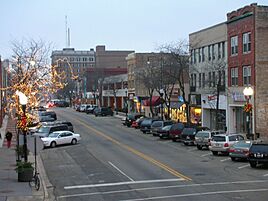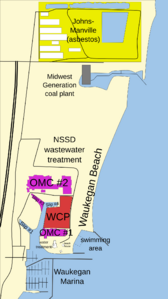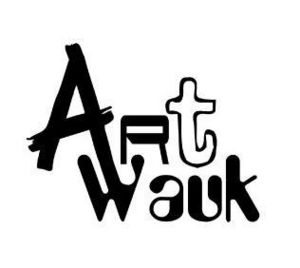Waukegan, Illinois facts for kids
Quick facts for kids
Waukegan, Illinois
|
||
|---|---|---|
|
Downtown Waukegan
Genesee Theatre
Waukegan Harbor Lighthouse
|
||
|
||
| Nickname(s):
WaukTown, Green Town
|
||
| Motto(s):
An Illinois Arts-Friendly Community
|
||

Location of Waukegan in Lake County, Illinois.
|
||
| Country | United States | |
| State | Illinois | |
| Counties | Lake | |
| Founded | 1829 | |
| Incorporated (town) | March 31, 1849 | |
| Incorporated (city) | February 23, 1859 | |
| Named for | Potawatomi: Wakaigin (Fortress or Trading Post) |
|
| Government | ||
| • Type | Mayor–council | |
| Area | ||
| • City | 24.47 sq mi (63.38 km2) | |
| • Land | 24.22 sq mi (62.72 km2) | |
| • Water | 0.26 sq mi (0.66 km2) 0.99% | |
| Elevation | 715 ft (218 m) | |
| Population
(2020)
|
||
| • City | 89,321 | |
| • Rank | 10th largest in Illinois 390th largest in U.S. |
|
| • Density | 3,688.36/sq mi (1,424.06/km2) | |
| • Metro | 9,472,676 | |
| Demonym(s) | Waukeganite | |
| Time zone | UTC−6 (CST) | |
| • Summer (DST) | UTC−5 (CDT) | |
| ZIP Codes |
60079, 60085, 60087
|
|
| Area code(s) | 847 & 224 | |
| FIPS code | 17-79293 | |
| U.S. Routes | ||
| Major State Routes | ||
| Waterways | Waukegan River | |
| Airports | Waukegan National Airport | |
Waukegan is the biggest city in Lake County, Illinois, United States. It is also the county seat, which means it's where the main government offices for the county are located. Waukegan is about 36 miles north of Chicago and is part of the larger Chicagoland area.
In 2020, Waukegan had a population of 89,321 people. This makes it the seventh-largest city in the Chicago area and the tenth-largest city in all of Illinois. Unlike some wealthy towns nearby, Waukegan has faced economic challenges, even though many middle-class families live there.
Contents
History of Waukegan
How Waukegan Began
The area where Waukegan is now was first called Rivière du Vieux Fort (Old Fort River) or Wakaygagh on a map from 1778. By the 1820s, people called it "Little Fort." The name "Waukegan" comes from the Potawatomi language, meaning "little fort." This new name was officially adopted on March 31, 1849.
Waukegan was an early supporter of ending slavery. In 1853, residents celebrated the freedom of enslaved people in the British Empire. It's even said that Abraham Lincoln once gave a speech in Waukegan but had to stop because of a fire alarm!
Growing into an Industrial City
In the mid-1800s, Waukegan started to become an important place for factories and businesses. Industries included building ships and wagons, milling flour, and raising sheep. The Waukegan Brewing Company was very successful. When the Chicago and Milwaukee Railway was built through Waukegan by 1855, it helped the city's industries grow even faster. Nearly 1,000 ships visited Waukegan harbor each year! During the 1860s, many German people moved to the city.
More industries came to Waukegan in the late 1800s, like the United States Sugar Refinery and Washburn & Moen, which made barbed wire. This brought many new people to the city, especially immigrants from countries like Sweden, Finland, and Lithuania. There was also a notable Armenian community.
Waukegan in the 1900s
In the 1920s and 1930s, many African Americans moved to Waukegan, mostly from the southern United States. The city faced some difficult times. For example, in June 1920, a misunderstanding led to a large group of sailors trying to attack a hotel where African Americans lived. The police stepped in to protect the residents.
Waukegan grew separately from Chicago for a long time. It was officially included in the Chicago metropolitan area in 2000. Even so, Waukegan has kept its own unique industrial feel, different from many of the residential suburbs near Chicago. Robert Sabonjian was a very important mayor for Waukegan, serving for 24 years. He was known for his strong leadership style.
Geography of Waukegan
Waukegan is located right on the shore of Lake Michigan. It's about 11 miles south of the Wisconsin border and 37 miles north of downtown Chicago. The city sits about 650 feet above sea level. Two major streets from Chicago, Sheridan Road and Milwaukee Avenue, lead north to Waukegan.
The city covers about 24.50 square miles. A small part of this area, about 0.24 square miles, is covered by water.
Major Streets in Waukegan
 Skokie Highway
Skokie Highway Waukegan Road
Waukegan Road Belvidere Road
Belvidere Road Green Bay Road
Green Bay Road Grand Avenue
Grand Avenue Sheridan Road/Amstutz Expressway
Sheridan Road/Amstutz Expressway- Lewis Avenue
- Washington Street
- Genesee Street
Climate in Waukegan
Waukegan has a climate with warm to hot summers that are often humid. Winters are cold and snowy. The highest temperature ever recorded was 108°F in July 1934. The lowest was -27°F in January 1985. Being close to Lake Michigan helps keep the city cooler throughout the year.
| Climate data for Waukegan, IL (1981–2010 normals) | |||||||||||||
|---|---|---|---|---|---|---|---|---|---|---|---|---|---|
| Month | Jan | Feb | Mar | Apr | May | Jun | Jul | Aug | Sep | Oct | Nov | Dec | Year |
| Record high °F (°C) | 64 (18) |
71 (22) |
83 (28) |
92 (33) |
95 (35) |
105 (41) |
108 (42) |
102 (39) |
103 (39) |
90 (32) |
80 (27) |
69 (21) |
108 (42) |
| Mean maximum °F (°C) | 48 (9) |
51 (11) |
67 (19) |
80 (27) |
86 (30) |
92 (33) |
95 (35) |
93 (34) |
90 (32) |
81 (27) |
67 (19) |
53 (12) |
96 (36) |
| Mean daily maximum °F (°C) | 29.9 (−1.2) |
34.1 (1.2) |
44.0 (6.7) |
55.9 (13.3) |
66.5 (19.2) |
77.0 (25.0) |
81.4 (27.4) |
80.0 (26.7) |
73.0 (22.8) |
61.0 (16.1) |
47.5 (8.6) |
34.2 (1.2) |
57.0 (13.9) |
| Daily mean °F (°C) | 22.5 (−5.3) |
26.5 (−3.1) |
35.9 (2.2) |
46.9 (8.3) |
56.8 (13.8) |
67.0 (19.4) |
72.3 (22.4) |
71.3 (21.8) |
63.4 (17.4) |
51.6 (10.9) |
39.8 (4.3) |
27.3 (−2.6) |
48.4 (9.1) |
| Mean daily minimum °F (°C) | 15.1 (−9.4) |
18.9 (−7.3) |
27.8 (−2.3) |
37.8 (3.2) |
47.0 (8.3) |
57.1 (13.9) |
63.2 (17.3) |
62.7 (17.1) |
53.8 (12.1) |
42.3 (5.7) |
32.1 (0.1) |
20.4 (−6.4) |
39.9 (4.4) |
| Mean minimum °F (°C) | −9 (−23) |
−3 (−19) |
8 (−13) |
23 (−5) |
32 (0) |
42 (6) |
49 (9) |
49 (9) |
38 (3) |
27 (−3) |
13 (−11) |
−2 (−19) |
−12 (−24) |
| Record low °F (°C) | −27 (−33) |
−24 (−31) |
−12 (−24) |
8 (−13) |
24 (−4) |
32 (0) |
41 (5) |
40 (4) |
27 (−3) |
11 (−12) |
−5 (−21) |
−23 (−31) |
−27 (−33) |
| Average precipitation inches (mm) | 1.69 (43) |
1.31 (33) |
2.25 (57) |
3.37 (86) |
3.37 (86) |
3.79 (96) |
3.29 (84) |
3.51 (89) |
3.43 (87) |
2.51 (64) |
2.43 (62) |
1.82 (46) |
32.31 (821) |
| Average snowfall inches (cm) | 10.8 (27) |
8.4 (21) |
6.4 (16) |
1.4 (3.6) |
0.0 (0.0) |
0.0 (0.0) |
0.0 (0.0) |
0.0 (0.0) |
0.0 (0.0) |
0.1 (0.25) |
2.0 (5.1) |
8.4 (21) |
36.4 (92) |
Environmental Cleanup Sites
Waukegan has three sites that are part of the Superfund program. This program helps clean up places where harmful substances have been found.
- In 1975, certain chemicals called PCBs were found in Waukegan Harbor. These chemicals came from a company called Outboard Marine Corporation (OMC). The company worked with the government to clean up the site, starting in 1990.
- The Johns Manville site, about 1 mile north of OMC, had asbestos contamination. Cleanup efforts began there in 1991 to cover the asbestos. More cleanup is still needed in some areas.
- The Yeoman Creek Landfill was used for trash from 1959 to 1969. It was found that liquids from the landfill were getting into the groundwater. Major cleanup work was finished in 2005, and monitoring of the water and air continues.
People of Waukegan
| Historical population | |||
|---|---|---|---|
| Census | Pop. | %± | |
| 1860 | 3,433 | — | |
| 1870 | 4,507 | 31.3% | |
| 1880 | 4,012 | −11.0% | |
| 1890 | 4,915 | 22.5% | |
| 1900 | 9,426 | 91.8% | |
| 1910 | 16,069 | 70.5% | |
| 1920 | 19,226 | 19.6% | |
| 1930 | 33,499 | 74.2% | |
| 1940 | 34,241 | 2.2% | |
| 1950 | 46,698 | 36.4% | |
| 1960 | 61,784 | 32.3% | |
| 1970 | 65,134 | 5.4% | |
| 1980 | 67,653 | 3.9% | |
| 1990 | 69,392 | 2.6% | |
| 2000 | 89,426 | 28.9% | |
| 2010 | 89,078 | −0.4% | |
| 2020 | 89,321 | 0.3% | |
| U.S. Decennial Census 2010 2020 | |||
Population and Diversity
Waukegan is a diverse city. In 2020, its population was 89,321. Many different cultures and backgrounds make up the community.
| Race / Ethnicity (NH = Non-Hispanic) | Pop 2000 | Pop 2010 | Pop 2020 | % 2000 | % 2010 | % 2020 |
|---|---|---|---|---|---|---|
| White alone (NH) | 27,186 | 19,370 | 14,003 | 30.93% | 21.74% | 15.68% |
| Black or African American alone (NH) | 16,354 | 16,240 | 14,647 | 18.61% | 18.23% | 16.40% |
| Native American or Alaska Native alone (NH) | 168 | 173 | 129 | 0.19% | 0.19% | 0.14% |
| Asian alone (NH) | 3,092 | 3,722 | 4,576 | 3.52% | 4.18% | 5.12% |
| Pacific Islander alone (NH) | 37 | 26 | 35 | 0.04% | 0.03% | 0.04% |
| Some other race alone (NH) | 398 | 577 | 817 | 0.45% | 0.65% | 0.91% |
| Mixed or Multiracial (NH) | 1,270 | 1,358 | 2,011 | 1.44% | 1.52% | 2.25% |
| Hispanic or Latino (any race) | 39,396 | 47,612 | 53,103 | 44.82% | 53.45% | 59.45% |
| Total | 87,901 | 89,078 | 89,321 | 100.00% | 100.00% | 100.00% |
Racial Makeup of Waukegan (2023) White alone (29.53%) Black alone (12.56%) Native American alone (3.32%) Asian alone (4.28%) Pacific Islander alone (0.00%) Some other race (28.99%) Two or more races (21.33%)
Racial Makeup of Waukegan treating Hispanics as a Racial Category (2023)
NH=Non-Hispanic White NH (17.07%) Black NH (12.45%) Native American NH (0.00%) Asian NH (4.21%) Pacific Islander NH (0.00%) Other race NH (0.12%) Two or more races NH (3.57%) Hispanic Any Race (62.58%)
Racial Makeup of Hispanics in Waukegan (2023) White alone (19.90%) Black alone (0.17%) Native American alone (5.31%) Asian alone (0.11%) Pacific Islander alone (0.00%) Other race alone (46.13%) Two or more races (28.38%)
As of the 2010 census, 53.4% of Waukegan's population was Hispanic or Latino. Many residents of Latin American descent are from Mexico, Honduras, Puerto Rico, Cuba, and Central America.
In 2000, the average household size was 3.09 people, and the average family size was 3.68 people. The median age in the city was 29 years old.
Religion in Waukegan
More than half of Waukegan's population belongs to a religious group. The largest group is Roman Catholics, making up 31.0% of residents. Other Christian groups include Lutherans, Baptists, Presbyterians, and Methodists. Other faiths like Judaism and Islam are also practiced.
Christ Episcopal Church is a historic church in Waukegan. The Roman Catholic Archdiocese of Chicago oversees Catholic churches in the city.
Economy and Growth
Top Employers in Waukegan
Many people work in Waukegan. Here are some of the biggest employers in the city as of 2023:
| # | Employer | # of Employees |
|---|---|---|
| 1 | Lake County | 2,400 |
| 2 | Southwire Co., LLC | 1,500 |
| 3 | Vista Medical Center East | 840 |
| 4 | Lake Behavioral Hospital | 700 |
| 5 | Medline Industries Inc. | 650 |
| 6 | Jewel-Osco | 515 |
| 7 | Waukegan Community Unit School District 60 | 500 |
| 8 | City of Waukegan | 483 |
| 9 | Bel Resources | 450 |
| 10 | Kiley Developmental Center | 425 |
City Revitalization Efforts
Waukegan has plans to improve its lakefront area. The goal is to replace most of the industrial businesses there with new homes and places for recreation. The city has also worked to attract new businesses and developers. The Genesee Theatre has been reopened, many new restaurants have started, and old buildings have been fixed up. The city has also invested in making downtown areas better for walking.
Waukegan also hosts "Scoop Unplugged," a monthly summer event where people drive their cool cars around downtown.
Things to Do in Waukegan
Popular Events
- ArtWauk is an art event held every third Saturday in downtown Waukegan. It showcases paintings, sculptures, films, dance, theater, comedy, music, and performance art.
- Chicago Latino Film Festival
- Fiestas Patrias Parade and Festival celebrates the independence of many Hispanic countries, including Mexico, Belize, and Honduras.
- HolidayWAUK (HolidayWalk) is downtown Waukegan's holiday festival.
Popular Tourist Destinations
- Downtown Waukegan: This is the main urban center of Lake County. You can find many restaurants, shops, the Waukegan Public Library, the College of Lake County, and the Lake County Courthouse here.
- The Temporary American Place Casino
- Genesee Theatre
- Waukegan Municipal Beach
- Waukegan Harbor Light
- Green Town on the Rocks outdoor music venue
- Ray Bradbury sites
- Waukegan History Museum
- Bowen Park
- Jack Benny Center for the Arts
- Lake County Sports Center
Notable People from Waukegan
Waukegan is the hometown of several famous people.
Jack Benny
Jack Benny (1894–1974) was a very famous comedian and entertainer. Even though he was born in Chicago, he always said Waukegan was his hometown because he grew up there. He often talked about Waukegan on his radio and TV shows.
The Jack Benny Middle School in Waukegan is named after him, which he said was one of his greatest thrills. A statue of Jack Benny stands downtown, facing the Genesee Theatre. His family lived in several houses in Waukegan, and the house at 518 Clayton Street is now a landmark.
Ray Bradbury
The well-known science-fiction author Ray Bradbury (1920–2012) was born in Waukegan. Even though his family moved to the West Coast when he was young, many of his stories are inspired by his childhood in Waukegan. He often called it "Green Town" in his books, like Dandelion Wine. Ray Bradbury Park in Waukegan is named in his honor.
Otto Graham
Pro Football Hall of Fame quarterback Otto Graham (1921–2003) was born and raised in Waukegan. He played football for the Cleveland Browns and led his team to championships almost every year between 1946 and 1955, winning seven of them. He holds the NFL record for the highest career winning percentage for a starting quarterback. Otto Graham is one of only two people to win championships in two major North American sports (basketball and football).
Shakedia Jones
Olympian and All-American track star Shakedia Jones (born 1979) grew up in Waukegan. In high school, she won nine state titles, which is the most in Illinois history. She went on to compete in the Junior Olympics and was an All-American sprinter at UCLA. Shakedia was also a member of the US Olympic Team at the 2000 Sydney Olympics.
Education in Waukegan
Most of Waukegan is served by Waukegan Public School District 60. This district teaches about 17,000 students from preschool through 12th grade. Waukegan has three early childhood schools, 13 elementary schools, five middle schools, and three high schools. Waukegan High School has two campuses: Brookside Campus for 9th and 10th graders, and Washington Campus for 11th and 12th graders.
Some parts of Waukegan are in other school districts, like Gurnee School District 56 and Warren Township High School District 121. There are also private schools in the city, such as Cristo Rey St. Martin College Prep (a Catholic high school) and Immanuel Lutheran School.
Transportation in Waukegan
Pace provides bus service throughout Waukegan, with a main station downtown. The Waukegan station offers Metra commuter train service. These trains travel south to Chicago and north to Kenosha, Wisconsin.
Historical Sites in Waukegan
- Bowen Park
- Naval Station Great Lakes
- Waukegan Building
- Waukegan Public Library
Sister Cities
Waukegan has one official sister city:
 Miyazaki, Japan
Miyazaki, Japan
Waukegan also has strong ties with Tonatico, Mexico. About 6,000 people from Tonatico live in Waukegan, creating ongoing connections between the two cities.
Images for kids
See also
 In Spanish: Waukegan para niños
In Spanish: Waukegan para niños


















